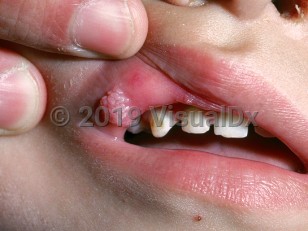Oral mucosal wart - Oral Mucosal Lesion
Alerts and Notices
Important News & Links
Synopsis

Oral mucosal warts, also known as papillomas, are asymptomatic small, soft, pink or white, slightly elevated papules and plaques on the buccal, gingival, or labial mucosa, tongue, or hard palate. They grow over the span of weeks to months. They are caused by human papillomavirus (HPV). More than 40 HPV types can infect the mucosa. The virus infects epithelial cells and can exist as a long-term latent infection that can reactivate or persist actively, even subclinically. Oral warts may result from digital or oral-genital sexual transmission. Condyloma acuminata are sexually transmitted and generally appear 1-3 months after exposure to an infected partner and present in multiple forms in the oral cavity.
Different HPV types have markedly different oncogenic potentials. High-risk HPV types include HPV-16, -18, -31, -33, and -45. Infections with HPV-6 and -11 are frequently detected in oral mucosal warts and occur commonly in benign or low-grade intraepithelial neoplasms but are very rarely associated with the development of malignancies.
Condyloma acuminata are caused by HPV-6, -11, -16, and -18.
Verruca vulgaris is associated with HPV types 2 and 4. In HIV-infected and other immunocompromised individuals, oral warts are frequently detected and may contain unusual HPV types, such as HPV-7, -71, -72, and -73.
Bowenoid papulosis has been reported in the mouth. Bowenoid papulosis may be considered as a transitional state between condyloma acuminatum (similar clinically) and Bowen disease (squamous cell carcinoma in situ) (similar histologically). Careful observation for recurrence and for the possibility of invasive or in situ malignancy is warranted.
A subtype of oral warts is Heck disease, also known as focal epithelial hyperplasia, which consists of multiple (or, rarely, single) smooth, white-to-pink papules found on the tongue, lips, palate, and floor of the mouth as well as the gingival, buccal, and labial mucosa. It is relatively common in children of South American Indian, Greenlander Eskimo, or South African descent. The lesions may clear spontaneously. It is strongly associated with HPV-13 and -32.
Related topic: genital wart
Different HPV types have markedly different oncogenic potentials. High-risk HPV types include HPV-16, -18, -31, -33, and -45. Infections with HPV-6 and -11 are frequently detected in oral mucosal warts and occur commonly in benign or low-grade intraepithelial neoplasms but are very rarely associated with the development of malignancies.
Condyloma acuminata are caused by HPV-6, -11, -16, and -18.
Verruca vulgaris is associated with HPV types 2 and 4. In HIV-infected and other immunocompromised individuals, oral warts are frequently detected and may contain unusual HPV types, such as HPV-7, -71, -72, and -73.
Bowenoid papulosis has been reported in the mouth. Bowenoid papulosis may be considered as a transitional state between condyloma acuminatum (similar clinically) and Bowen disease (squamous cell carcinoma in situ) (similar histologically). Careful observation for recurrence and for the possibility of invasive or in situ malignancy is warranted.
A subtype of oral warts is Heck disease, also known as focal epithelial hyperplasia, which consists of multiple (or, rarely, single) smooth, white-to-pink papules found on the tongue, lips, palate, and floor of the mouth as well as the gingival, buccal, and labial mucosa. It is relatively common in children of South American Indian, Greenlander Eskimo, or South African descent. The lesions may clear spontaneously. It is strongly associated with HPV-13 and -32.
Related topic: genital wart
Codes
ICD10CM:
B07.8 – Other viral warts
SNOMEDCT:
402908003 – Oral wart
B07.8 – Other viral warts
SNOMEDCT:
402908003 – Oral wart
Look For
Subscription Required
Diagnostic Pearls
Subscription Required
Differential Diagnosis & Pitfalls

To perform a comparison, select diagnoses from the classic differential
Subscription Required
Best Tests
Subscription Required
Management Pearls
Subscription Required
Therapy
Subscription Required
References
Subscription Required
Last Reviewed:08/09/2022
Last Updated:08/10/2022
Last Updated:08/10/2022

